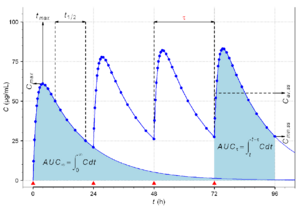Medicine:Peak-to-trough ratio
From HandWiki
Short description: Pharmacokinetic metrics
Peak-to-trough ratio (PTR), also known as peak-to-trough variation or peak-to-trough fluctuation, is a parameter in pharmacokinetics which is defined as the ratio of Cmax (peak) concentration and Cmin (trough) concentration over a dosing interval for a given drug.[1][2] A drug with an elimination half-life of 24 hours taken once per day will have a peak-to-trough ratio of approximately 2.[1] Peak-to-trough ratio is proportional to half-life and to dosing interval, with longer half-lives and shorter dosing intervals giving smaller ratios.[3]
References
- ↑ 1.0 1.1 Pharmacokinetics and Metabolism in Drug Design (3 ed.). John Wiley & Sons. 13 September 2012. pp. 24–. ISBN 978-3-527-64529-9. OCLC 1162264997. https://books.google.com/books?id=tz6khNt2wSYC&pg=PA24.
- ↑ Joseph T. DiPiro (2010). Concepts in Clinical Pharmacokinetics. ASHP. pp. 60–. ISBN 978-1-58528-241-8. OCLC 1058071530. https://books.google.com/books?id=vMI_cPtEqdQC&pg=PA60.
- ↑ George Morrison Maxwell (6 December 2012). Principles of Paediatric Pharmacology. Springer Science & Business Media. pp. 35–. ISBN 978-1-4684-7544-9. OCLC 1012476802. https://books.google.com/books?id=1zzjBwAAQBAJ&pg=PA35.
 |


